Related Research Articles

The Scarpe is a river in the Hauts-de-France region of France. It is a left-bank tributary of the river Escaut (Scheldt). It is approximately 100 kilometres (62 mi) long. The source of the river is at Berles-Monchel near Aubigny-en-Artois. It flows through the towns of Arras, Douai and Saint-Amand-les-Eaux. The river ends at Mortagne-du-Nord where it flows into the Scheldt. Scarpe Mountain in Alberta, Canada, was named after the river. The navigable waterway and its coal barges also feature in the novels by 19th century author Émile Zola.

The Oise is a river of Belgium and France, flowing for 341 kilometres (212 mi) from its source in the Belgian province of Hainaut, south of Chimay. It crosses the border with France after about 20 kilometres (12 mi). It flows into the Seine at Conflans-Sainte-Honorine, a north-western suburb of Paris. Its main tributary is the Aisne. It gave its name to the French departments of Oise and Val-d'Oise.
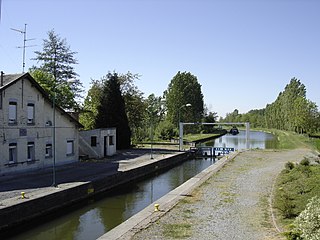
The Canal de laSambre à l'Oise is a canal in northern France. It forms a connection between the canalised river Sambre at Landrecies and the Oise at La Fère. The canal is 71 kilometres (44 mi) long, and has 38 locks. The junction made at La Fère is with a branch of the Canal de Saint-Quentin, while the Canal latéral à l'Oise is joined 10.5 km further downstream at Chauny. It was used by the standard Freycinet-gauge péniches, 38.50 metres (126.3 ft) long, and 5.05 metres (16.6 ft) in beam, carrying up to 250 tonnes. The canal, also a popular waterway for boats heading south from the Netherlands and Belgium to the central French waterways, had to be closed in 2006 when two aqueducts were found to be in danger of failing. Funding has been put in place by the owner, Voies Navigables de France, and the local authorities, with support from the State, and it is expected to reopen the canal throughout in 2020.

The Canal Saint-Martin is a 4.6 km long canal in Paris, connecting the Canal de l'Ourcq to the river Seine. Over nearly half its length, between the Rue du Faubourg du Temple and the Place de la Bastille, it was covered, in the mid-19th century, to create wide boulevards and public spaces on the surface. The canal is drained and cleaned every 10–15 years, and it is always a source of fascination for Parisians to discover curiosities and even some treasures among the hundreds of tonnes of discarded objects.
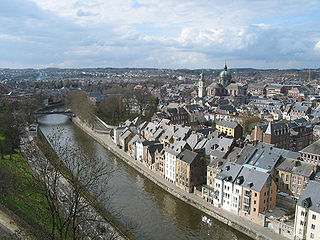
The Sambre[sɑ̃bʁ] is a river in northern France and in Wallonia, Belgium. It is a left-bank tributary of the Meuse, which it joins in the Wallonian capital Namur.

The Mayenne is a 202.3 km (125.7 mi) long river in western France principally located in the French region of Pays de la Loire. Together with the river Sarthe and its tributary the Loir it forms the Maine, which is a tributary to the Loire.

The Charente is a 381-kilometre (237 mi) long river in southwestern France. Its source is in the Haute-Vienne département at Chéronnac, a small village near Rochechouart. It flows through the departments of Haute-Vienne, Charente, Vienne and Charente-Maritime. The river flows into the Atlantic Ocean near Rochefort.

The Lot, pronounced [lɔt], originally the Olt, is a river in France. It is a right-bank tributary of the Garonne. It rises in the Cévennes mountains, flowing west through Quercy, where it flows into the Garonne near Aiguillon, a total distance of 481 kilometres (299 mi). It gives its name to the départements of Lot and Lot-et-Garonne.

The Aisne is a river in northeastern France. It is a left tributary of the Oise. It gave its name to the French department of Aisne. It was known in the Roman period as Axona.

The Aa is an 89-kilometre (55 mi) long river in northern France. Its source is near the village of Bourthes. The name Aa is Old Dutch. It means water, and can be traced back to its original Indo-European form as such.

The Canal du Centre, originally known as the Canal du Charollais, is a French canal running from Digoin, where it now joins the Canal latéral à la Loire, to the Saône at Chalon-sur-Saône. It was opened in 1792 and was the first watershed canal allowing boats to pass from the north of France to the south. It is 112.1 kilometres (69.7 mi) long and has 61 locks. Most of its traffic was generated by now abandoned coal mines at Montceau-les-Mines.
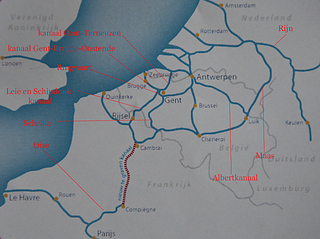
The Seine–Nord Europe Canal is a projected high-capacity canal in France that would link the Oise River at Compiègne with the Canal Dunkerque-Escaut, east of Arleux. The objective is to expand trade flows in a fuel-efficient and ecologically friendly manner between the Seine basin and Belgium, Germany and the Netherlands, while reducing saturation on the A1 motorway in France and reducing the CO2 emissions in the transport sector within this corridor.

The Canal de l’Aisne à la Marne is a canal in northeastern France which connects the Aisne and the Marne valleys. It runs from the Canal latéral à l'Aisne at Berry-au-Bac to Condé-sur-Marne on the Canal latéral à la Marne, a distance of 58 km. The canal rises 40m through 16 locks via the cathedral city of Reims, which is also a busy commercial port, to a summit level at an altitude of 95.70m. After crossing the watershed through a tunnel 2302m long at Mont-de-Billy, the canal drops down 23.80m through a flight of 8 locks towards the Marne.
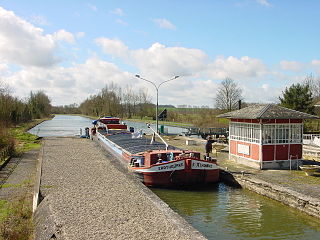
The Canal de Saint-Quentin is a canal in northern France connecting the canalised Escaut River in Cambrai to the Canal latéral à l'Oise and Canal de l'Oise à l'Aisne in Chauny.
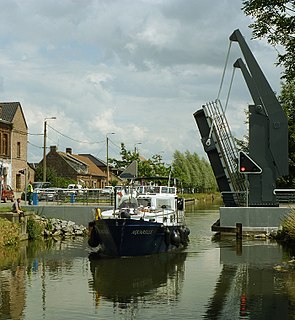
The Canal de Roubaix is a canal in northern France. It joins the Canal de la Deûle near Marquette-lez-Lille to the Canal de l’Espierres in Belgium at Leers, just east of the former textile manufacturing town Roubaix. It is 20 km long with 12 locks. The Belgian canal continues 8.4 km and three locks beyond the border to the junction with the river Escaut (Scheldt).

The Canal Dunkerque-Escaut is a 189 km long series of historic canals, and the canalised river Escaut (Scheldt) that were substantially rebuilt from the mid-1950s up to ca. 1980, with some new sections, from Dunkerque to the Belgian border at Mortagne-du-Nord. Existing canals were straightened and widened; and new locks (écluses) were built, also on the river Escaut, from the junction at Bouchain to the border.The route is also known as the Liaison 'à grand gabarit'Dunkerque-Escaut. Some authors have separated the waterway into the canal proper and the canalised river Escaut, but current practice is to use the simple name throughout. The Liaison was designed for large commercial vessels up to 85m long by 11.50m wide. The entire route is being further upgraded to offer European Class Vb dimensions, for push-tows 185m by 11.50m, and motor barges up to 125m long, as part of the current EU-funded Seine-Escaut-Rhine waterway corridor investments, including the new Seine-Nord Europe Canal.

The Canal de la Haute Colme is a canal in northern France. The haute Colme corresponds to the western segment of the Canal de la Colme. The channel connects Aa River at Watten to Canal de Bergues and Canal de la Basse Colme at Bergues. Between Watten and Cappelle-Brouck, it is part of the Canal Dunkerque-Escaut.

The Canal de la Deûle is one of the oldest canals in northern France, originally connecting the river Scarpe near Douai with the river Lys at Deûlémont near the Belgian border. Roughly half of its original length has been absorbed in the high-capacity Dunkerque-Escaut waterway, as shown on the map, and the remaining length through the port of Lille is often considered as a branch of the main route, hence the alternative names Liaison or Antenne Bauvin-Lys. This official name was never adopted by the local population, which refers simply to the Deûle, evoking its original state as a natural river, although it has the size and the appearance of a built canal. It is 34.8 kilometres (21.6 mi) long with 3 locks.

The Canal de Calais connects the Aa River near Ruminghem to the inner basins of the Port of Calais. Many boats enter the French canal system through the port of Calais and this canal. It is 30 km long and has 3 locks.
References
- ↑ Edwards-May, David (2010). Inland Waterways of France. St Ives, Cambs., UK: Imray. pp. 41–42. ISBN 978-1-846230-14-1.